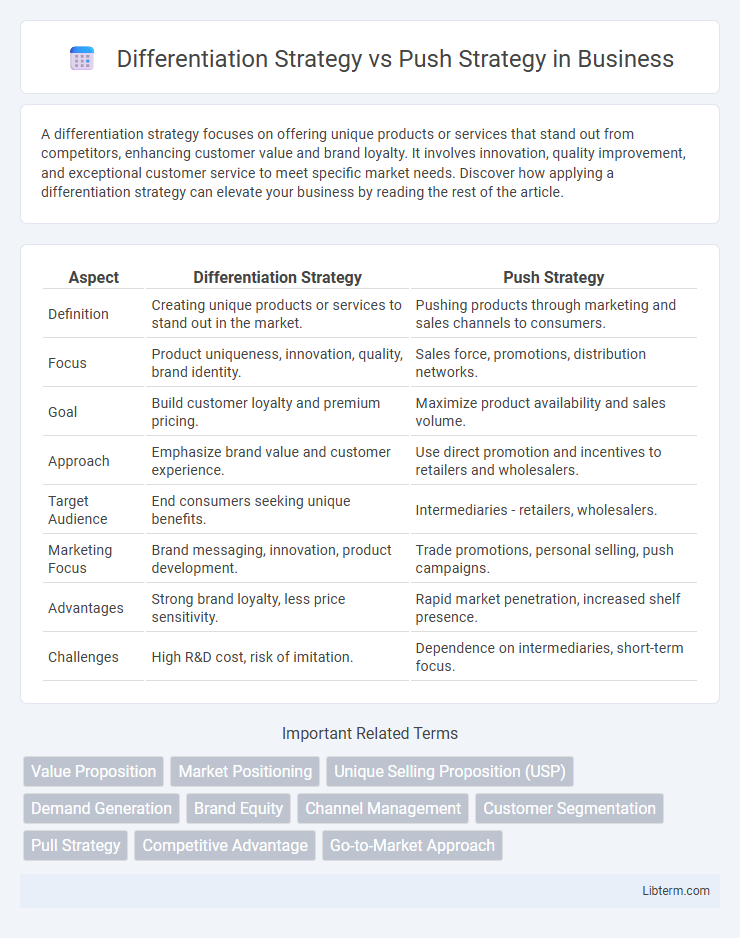A differentiation strategy focuses on offering unique products or services that stand out from competitors, enhancing customer value and brand loyalty. It involves innovation, quality improvement, and exceptional customer service to meet specific market needs. Discover how applying a differentiation strategy can elevate your business by reading the rest of the article.
Table of Comparison
| Aspect | Differentiation Strategy | Push Strategy |
|---|---|---|
| Definition | Creating unique products or services to stand out in the market. | Pushing products through marketing and sales channels to consumers. |
| Focus | Product uniqueness, innovation, quality, brand identity. | Sales force, promotions, distribution networks. |
| Goal | Build customer loyalty and premium pricing. | Maximize product availability and sales volume. |
| Approach | Emphasize brand value and customer experience. | Use direct promotion and incentives to retailers and wholesalers. |
| Target Audience | End consumers seeking unique benefits. | Intermediaries - retailers, wholesalers. |
| Marketing Focus | Brand messaging, innovation, product development. | Trade promotions, personal selling, push campaigns. |
| Advantages | Strong brand loyalty, less price sensitivity. | Rapid market penetration, increased shelf presence. |
| Challenges | High R&D cost, risk of imitation. | Dependence on intermediaries, short-term focus. |
Introduction to Differentiation Strategy and Push Strategy
Differentiation strategy focuses on creating unique product features, quality, or branding to stand out in the market and attract a specific customer segment willing to pay a premium. Push strategy involves promoting products by pushing them through distribution channels to end consumers using aggressive sales tactics, promotions, and trade incentives. Both strategies aim to increase market share but differ in approach; differentiation emphasizes product distinctiveness, while push centers on demand stimulation through intermediaries.
Defining Differentiation Strategy
Differentiation strategy refers to a marketing approach where a company develops unique products or services to stand out from competitors, emphasizing distinctive features, quality, or brand image that add value to customers. It focuses on creating a competitive advantage by addressing specific customer needs and preferences through innovation, design, or superior performance. This strategic positioning aims to attract and retain customers willing to pay a premium for perceived uniqueness.
Key Elements of Push Strategy
Push strategy centers on actively promoting products through distribution channels to encourage retailers and wholesalers to stock and sell items, emphasizing personal selling, trade promotions, and direct incentives. Key elements include trade shows, point-of-sale displays, and volume discounts aimed at channel partners to increase product visibility and availability. This approach contrasts with differentiation strategy by focusing on supply chain influence rather than creating unique product features or brand identity.
Core Objectives: Differentiation vs Push
Differentiation strategy centers on creating unique products or services that offer distinct value and stand out in the marketplace to attract targeted customer segments. Push strategy focuses on actively promoting products through channels such as sales force and trade promotions to drive demand and encourage immediate purchase. The core objective of differentiation is to build brand loyalty through uniqueness, while push strategy aims to accelerate product adoption and increase sales volume rapidly.
Target Audience and Market Focus
Differentiation strategy targets niche or specific customer segments seeking unique product features or superior quality, emphasizing brand loyalty and premium pricing in competitive markets. Push strategy focuses on broadening market reach by promoting products through strong sales efforts and distribution channels, aiming to convert intermediaries and retailers to push products to end consumers. Market focus in differentiation leans towards specialized, value-driven segments, while push strategy prioritizes volume and market penetration across wider audiences.
Implementation Methods for Each Strategy
Implementation of a Differentiation Strategy involves creating unique product features, investing in advanced technology, and enhancing customer service to build brand loyalty and justify premium pricing. Push Strategy implementation centers on aggressive sales tactics, including trade promotions, direct selling, and channel incentives to motivate intermediaries to stock and promote products. Effective execution of both strategies requires aligning marketing, sales, and distribution efforts to maximize competitive advantage and market penetration.
Benefits and Drawbacks Comparison
Differentiation strategy offers the benefit of creating unique products that justify premium pricing and foster brand loyalty but can incur higher costs and limit market reach. Push strategy effectively stimulates demand through aggressive promotions and strong distributor relationships, driving immediate sales growth yet may result in reduced profit margins and reliance on intermediaries. Balancing differentiation's long-term brand strength with push strategy's short-term sales effectiveness helps businesses optimize market positioning.
Case Studies: Differentiation and Push in Action
Case studies showcase how Apple's differentiation strategy leverages innovative design and unique user experiences to command premium market positioning, while Procter & Gamble's push strategy emphasizes aggressive distribution and trade promotions to boost product availability and immediate sales. Tesla's differentiation focuses on cutting-edge electric vehicle technology and brand prestige, contrasting with Coca-Cola's push tactics that rely on extensive retailer partnerships and in-store displays to drive volume. These real-world examples highlight the strategic trade-off between creating distinct customer value and maximizing market penetration through intensive promotional efforts.
Choosing the Right Strategy for Your Business
Choosing the right strategy between differentiation and push depends on your business goals and market dynamics. Differentiation strategy emphasizes unique product features and brand identity to attract customers willing to pay a premium, ideal for businesses targeting niche markets. Push strategy focuses on aggressive sales and distribution efforts to increase product availability and prompt immediate purchases, making it suitable for companies aiming for rapid market penetration and volume sales.
Conclusion and Strategic Recommendations
Differentiation strategy enhances competitive advantage by emphasizing unique product features, quality, or brand reputation, attracting customer segments willing to pay premium prices. Push strategy drives product demand through aggressive promotion and sales forces, effectively boosting short-term sales volume and market penetration. Companies should integrate differentiation to build long-term brand loyalty while employing push tactics selectively during product launches or promotions for optimized market impact.
Differentiation Strategy Infographic

 libterm.com
libterm.com